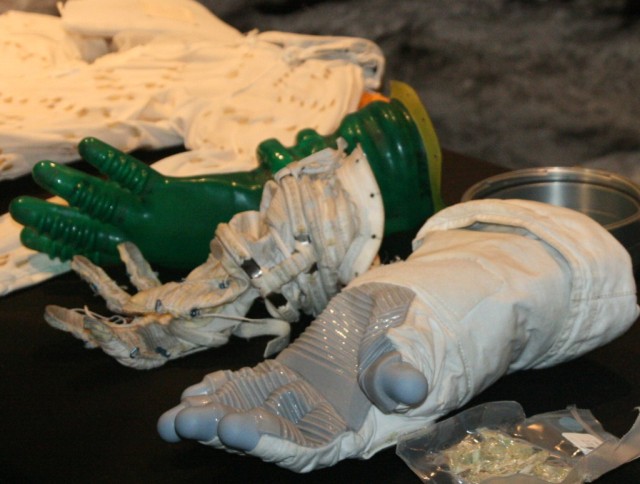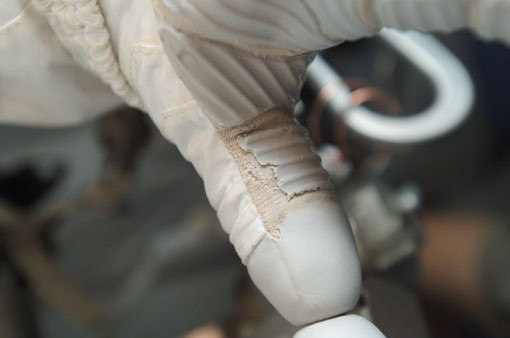 On the picture to the right, you see the actual layers of a current space glove. I shot this picture when I attended World Space Expo 2007 at Kennedy Space Center. The green part on the left is the inner pressure bladder, the one in the middle is worn above it and can be configured to the astronauts hand. The white glove to the right is the outer layer. NASA always speaks of five glove layers, but I think this refers to layers of material brought up onto the three different glove parts you see in the picture. At least, I could not find anything else (if you happen to know, I’d appreciate to learn about it).
On the picture to the right, you see the actual layers of a current space glove. I shot this picture when I attended World Space Expo 2007 at Kennedy Space Center. The green part on the left is the inner pressure bladder, the one in the middle is worn above it and can be configured to the astronauts hand. The white glove to the right is the outer layer. NASA always speaks of five glove layers, but I think this refers to layers of material brought up onto the three different glove parts you see in the picture. At least, I could not find anything else (if you happen to know, I’d appreciate to learn about it).
On the recent international space station spacewalks (aka “EVA”), there were very often problems with cut or punctured gloves. Thankfully, these cuts were always only in the outer layers, posing no risk to the spacewalkers. It is believed that there are some unknown sharp edges at the space station, but nobody knows for sure where (thus they are unknown ;)).
Below, find a picture of a damaged space glove. This was taken after a spacewalk on the STS-118 mission:
To protect the astronauts, frequent checking of the gloves is now a requirement during spacewalks. However, the detection of a glove issue can cut a spacewalk short and thus seriously compromise the mission. To prevent that problem, STS-122 spacewalkers will wear overgloves. They made their first live test on the STS-120 spacewalk devoted to repairing the torn solar array.
I have not yet seen an actual picture of these overgloves. But obviously, they cause some loss of feeling and flexibility. As such, tasks carried out by the astronauts may take a bit longer than usual. NASA has put only a conditional order to wear the overgloves. For delicate work, spacewalkers may remove them. This is also possible if time is running out on spacewalk. This poses no extra risk, as the rigid glove-checking guidelines then apply. So the overgloves are actually more to save the mission than the astronaut.




